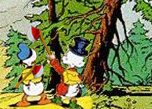 "The way to get started is to quit talking and begin doing" Walt Disney used to say.Books area great source of new ideas, inspiration, and discovery, especially for kids. Walt Disney knew this, which is why Disney stories often carry inspirational messages for kids, urging them to dream big and imagine magical kingdoms full of laughter and happiness.In comparison, the procurement policy announced by Disney is depressing.Rainforest Action Network (RAN), called Disney to act, to protect rainforests. The company''s U.S. publishing business, which produces 50 million books and 30 million magazines a year. That's a lot of paper and a lot of trees.
"The way to get started is to quit talking and begin doing" Walt Disney used to say.Books area great source of new ideas, inspiration, and discovery, especially for kids. Walt Disney knew this, which is why Disney stories often carry inspirational messages for kids, urging them to dream big and imagine magical kingdoms full of laughter and happiness.In comparison, the procurement policy announced by Disney is depressing.Rainforest Action Network (RAN), called Disney to act, to protect rainforests. The company''s U.S. publishing business, which produces 50 million books and 30 million magazines a year. That's a lot of paper and a lot of trees.
The new paper policy is Disney's response is disappointing and slippery. "Disney seeks to have 100% of paper sourced for product and packaging by its non-licensed businesses be sustainable. The paper sourced will contain recycled content, be sourced from certified forests, or be of known source origin."
It seems a nice answer, colorful and shining, but, what does it mean?
Recycled content: very good, the post-consumer type - it has the smallest environmental footprint. But it's not clear how much recycled content Disney is committing to in this policy. Are we talking 2% in 15 years or 45% by the year's end? There's a big difference, and that's why we tell companies that strong policies must include numeric, time-bound goals on percentage of post-consumer recycled content. What is a commitment without numbers, and dates? Disney missed in its policy.
Virgin fibres and certified forests: from bad to worst.... "Disney shall accept certification documentation for recycled and virgin paper from the Forest Stewardship Council (FSC), Programme for Endorsement of Forest Certification Claims (PEFC), Canadian Standards Association (CSA), and the Sustainable Forestry Initiative (SFI). Additional certification systems may be evaluated by Disney on a case-by-case basis."
Unfortunately, among many colorful brands available the market, only FSC provides real environmental and social safeguards practices of forest management. While other leading companies like Scholastic, Hachette, Timberland, Gucci Group, and many others include a clear preference for FSC-certified forest products in their corporate policies, Disney does not. In excluding this preference, Disney implies that all certifications are equal for the world's forests and forest peoples. This is simply untrue.
The last of the three criteria for paper products included in Disney's paper policy is that they be of "known source origin," meaning that they were not illegally harvested. While legality is a minimum bar, and we encourage all companies to know where their supply is coming from and ensure it is legal, legality almost never
But legality is a minimum bar, is not an added quality, it doesn't imply social responsibility. What's worse is that the only proof the Disney policy requires is a declaration of legality by the supplier - the party with the greatest interest in claiming the products they are selling is legal, whether that's 100% true or not. Did ever a supplier declare the opposite? "No, the paper I'm selling to you it is entirely illegal, I certify it." So what does all this mean?
Disney states "Nature conservation is a top Disney priority." Other U.S. children's publishers, including Scholastic, Hachette, Simon & Schuster, and many others, have comprehensive paper policies and additional commitments to move away from controversial Indonesian suppliers Asia Pulp and Paper (APP) and APRIL while eliminating controversial Indonesian fiber until key reforms have been undertaken. Disney can certainly do as well as they do, but it doesn't. What sort of priority of nature conservation for Disney?
"The way to get started is to quit talking and begin doing" Walt Disney used to say. Somebody has to remind it to Disney Company.


